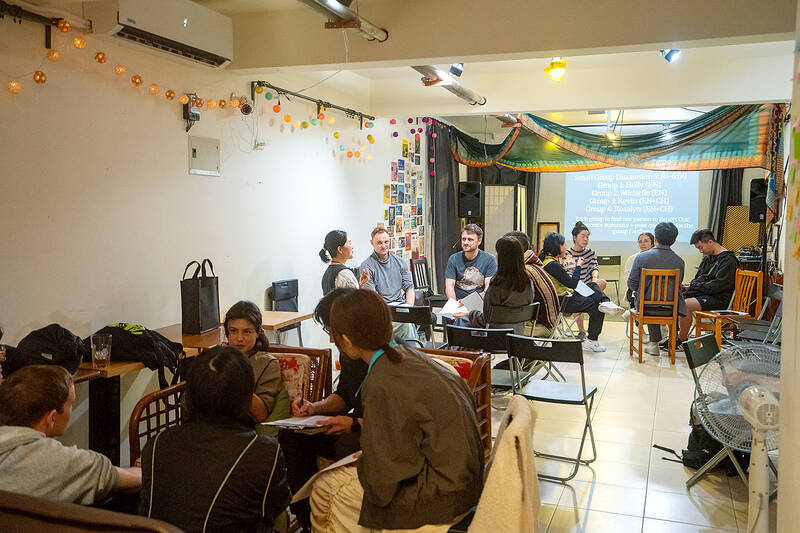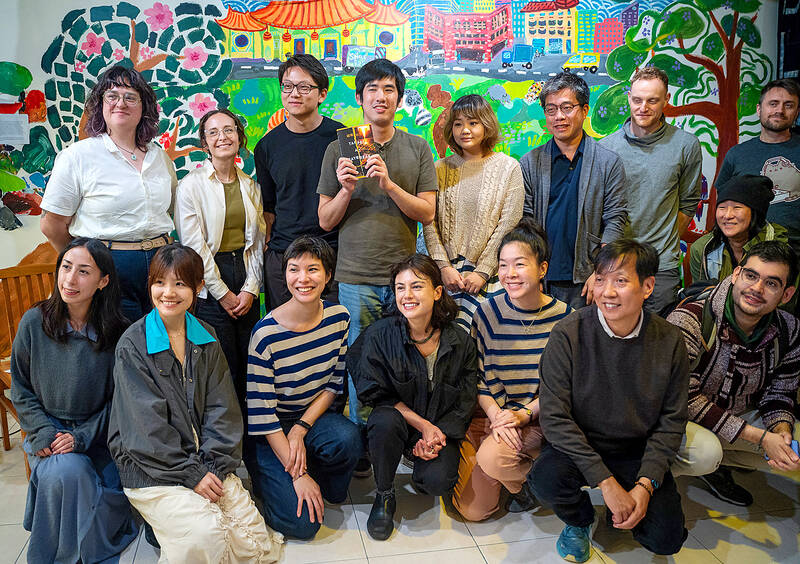Brian Hioe says that New Bloom started out as a group of like-minded youth activists that eventually transformed into a publication, a project detailing the Sunflower movement’s oral history and now an event space where all manner of passionate individuals come together to discuss pressing issues facing Taiwan.
“New Bloom happened because a couple of people talked at a protest,” Hioe says.
We’re sitting in a cafe in Taipei, surrounded by affirmations of Taiwanese identity and sovereignty, discussing Hioe’s new novel, Taipei at Daybreak, a fictionalized account of his own participation in the Sunflower movement in 2014.

Photo: Lery Hiciano, Taipei Times
The following week, Hioe answers questions from readers during a reading club event at Daybreak, a local cafe and social club for New Bloom, a magazine that he and several fellow activists founded in the aftermath of the Sunflower movement.
At Daybreak, one might see a local independent candidate running for city council, an expert on survival tactics, a pro-trans fundraising event or a talk on the difficulties faced by Taiwan’s Southeast Asian laborer population.
Hioe and New Bloom are unapologetic in the causes they support and the politics they wear on their sleeves, the walls adorned with flags and posters of everything from White Terror remembrance events to Ukraine-inspired drinks on the menu.

Photo: Lery Hiciano, Taipei Times
Hioe’s new book, much like everything else New Bloom does, is at the intersection of youthful idealism about how the world should be and its harsh realities.
Following a launch event for his novel, Hioe spoke to the Taipei Times about the writing process, the importance of memory in defining identity and his role as a conduit within Taiwan’s activism scene.
THE WRITING PROCESS

Photo: Lery Hiciano, Taipei Times
Starting in 2017 and 2018, Hioe began to write what later became Taipei at Daybreak, using his excerpts of earlier works dating back to as early as 2011 when he was just starting to enter the world of social activism.
“Everything that happens to the protagonist is something that happened to me,” Hioe says, although he mentions he made changes for the sake of narrative.
The book, written using material from both the time of the movement and later additions, is an “odd dialogue of myself,” Hioe says.
To Hioe, the book is a testament to how much Taipei has changed.
“The memory of the Sunflower movement is gone,” he says. Three consecutive presidential elections have gone in favor of the Democratic People’s Party (DPP), Taiwanese identity as something distinct from China has become much more mainstream and tensions between Washington and Beijing have focused international attention on Taipei in a way that was unimaginable when the movement first started.
SOCIAL MEMORY AND IDENTITY
Hioe says the book is about waishengren (外省人) identity, or the identity of those who fled to Taiwan after the Chinese Nationalist Party (KMT) lost the Chinese Civil War in 1949. The KMT ruled over the island with an iron fist for most of the following four decades.
Hioe says his protagonist descended from waishengren, adding that he’s fascinated by the idea that a victim can also be a victimizer. “That reflects my own family’s history,” he says.
Much of Taiwan’s literary history and the works that historically gained international attention have been the work of waishengren authors, he says.
From the novel’s first page, the main character’s push and pull between Chinese and Taiwanese identity is frequent, culminating in a climactic inward look on how he declares he may “revenge myself upon my own past and all those who had suffered under us.”
It is a stark example of Hioe’s views on the cyclical nature of societal trauma, and where all must eventually come to terms with their own complicated inheritances.
“I’m very sympathetic to that sense of trauma, but then from that trauma you often just become another victimizer,” he says.
He added that the “vacuum” of trauma has “still not been filled.”
While the protagonist considers violent outcomes to solve the issue, Hioe himself has participated in primarily peaceful movements.
“Part of what I am trying to get at with this novel is the sense of desperation that pushed people into the legislature, take such a desperate act, breaking the law, fighting with the police ... And we’ve forgotten that.”
In this cafe, sitting under a snake drawing on the wall charting out Taiwan’s democratization throughout the 20th century, Hioe says, “this place is where the characters in the novel meet after the incident at the [legislature].”
Placing the novel within the context of increasing attention on Taiwanese stories, from movies such as Didi to other novels like the Taiwan Travelogue, Hioe admitted that this is a “moment,” but admitted he sees this book as more about Taiwan than about the Taiwanese diaspora of which he is a part.
It is part of a larger balancing act he finds himself trying to perfect, living in Taipei while primarily writing in English for an audience that is not very local. Daybreak, as a space, often attracts Taiwanese who lived or grew up abroad, as well as ex-pats interested in the local culture but not always a part of it.
“In the early 2010s, there was a lack of knowledge of Asia, which has changed a lot […] There is a struggle for identity that’s part of it, but that’s not what I was thinking of when I wrote it. I wanted to be grounded in the historical moment, but also the city. This city of protests,” Hioe says.
Although the book, as he said, is in many ways about identity, social movements, and his own experiences, Taipei is as much of a character as any of the humans. He names streets, landmarks, sights and smells that are familiar to residents, even if they describe locations that have moved, closed or have changed with the times.
Yet Hioe remains focused on Taipei’s memory, not as an imagined past or a source of nostalgic pain, but as a living entity that carries memories of its past. It is why the same week as he launched his book and spoke to the Taipei Times, he led a group on a walking tour of Zhongzheng District (中正), teaching participants about the 228 Incident and what occurred on those streets generations before that still resonates to the present day.
“One change I’d like to see in Taiwan? Dissolve the KMT,” Hioe says.

Most heroes are remembered for the battles they fought. Taiwan’s Black Bat Squadron is remembered for flying into Chinese airspace 838 times between 1953 and 1967, and for the 148 men whose sacrifice bought the intelligence that kept Taiwan secure. Two-thirds of the squadron died carrying out missions most people wouldn’t learn about for another 40 years. The squadron lost 15 aircraft and 148 crew members over those 14 years, making it the deadliest unit in Taiwan’s military history by casualty rate. They flew at night, often at low altitudes, straight into some of the most heavily defended airspace in Asia.

Many people in Taiwan first learned about universal basic income (UBI) — the idea that the government should provide regular, no-strings-attached payments to each citizen — in 2019. While seeking the Democratic nomination for the 2020 US presidential election, Andrew Yang, a politician of Taiwanese descent, said that, if elected, he’d institute a UBI of US$1,000 per month to “get the economic boot off of people’s throats, allowing them to lift their heads up, breathe, and get excited for the future.” His campaign petered out, but the concept of UBI hasn’t gone away. Throughout the industrialized world, there are fears that

Like much in the world today, theater has experienced major disruptions over the six years since COVID-19. The pandemic, the war in Ukraine and social media have created a new normal of geopolitical and information uncertainty, and the performing arts are not immune to these effects. “Ten years ago people wanted to come to the theater to engage with important issues, but now the Internet allows them to engage with those issues powerfully and immediately,” said Faith Tan, programming director of the Esplanade in Singapore, speaking last week in Japan. “One reaction to unpredictability has been a renewed emphasis on

Taiwan’s democracy is at risk. Be very alarmed. This is not a drill. The current constitutional crisis progressed slowly, then suddenly. Political tensions, partisan hostility and emotions are all running high right when cool heads and calm negotiation are most needed. Oxford defines brinkmanship as: “The art or practice of pursuing a dangerous policy to the limits of safety before stopping, especially in politics.” It says the term comes from a quote from a 1956 Cold War interview with then-American Secretary of State John Foster Dulles, when he said: ‘The ability to get to the verge without getting into the war is